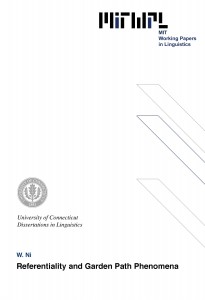Referentiality and Garden Path Phenomena
W. Ni, 1991
ABSTRACT
A central goal of psycholinguistic research is to identify the basis and the time course in resolving structural ambiguities. Evidence bearing on this issue comes from so-called "garden path effects", as occur in sentences like (1). Comprehension is consistently derailed in (1) when the perceiver encounters the word received. This dissertation attempts to find out why.
(1) The students furnished answers before the exam received high marks.
Two main accounts of ambiguity resolution are contrasted. One, the Garden Path Theory, maintains that the perceiver computes a single analysis of ambiguous word strings using structurally-based parsing strategies. A garden path effect occurs in (1), on this view, because the morphologically ambiguous word furnished is initially analyzed as the main verb, so that the subsequently encountered verb received cannot be incorporated into the analysis.
The alternative account, the Referential Theory, explains garden path effects as due to the relative complexity of the semantic/pragmatic representations associated with the alternative analyses of an ambiguous phrase. On this account, syntax proposes and semantics/pragmatics disposes among all structural analyses.
Three experiments were conducted to test between the competing accounts. One compared sentences like (1) and (2). These sentences are structurally identical at the point where the ambiguity arises. Therefore, the Garden Path Theory predicts no processing difference between them. By contrast, the Referential Theory predicts that the substitution of only for the in the initial noun phrase should avoid garden path effects for the perceiver.
(2) Only students furnished answers before the exam received high marks.
A self-paced word-by-word reading task was used in all these experiments. Subjects read test sentences one word at a time and decided at each word whether the sentence continued to be acceptable. Both the accuracy and the reaction time data indicated severe comprehension breakdowns with sentences like (1), while the results for sentences like (2) were indistinguishable from that of their unambiguous controls. The findings confirm the predictions of the Referential Theory, but not those of the Garden Path Theory. It is concluded that the perceiver makes on-line use of semantic/pragmatic information in ambiguity resolution.
TABLE OF CONTENTS
APPROVAL PAGE ..........................................................................ii
ACKNOWLEDGMENTS .................................................................iv
Chapter 1. INTRODUCTION ..............................................................1
1.1. Ambiguities in Sentence Processing ..............................................1
1.2. Use of Linguistic Information: What, When, and How ........................5
1.3. Organization of the Thesis ..........................................................................10
1.4. Endnotes .............................................................................11
Chapter 2. THEORETICAL BACKGROUND .....................................................13
2.1. The Modularity Hypothesis ......................................................13
2.2. PDP - - Against Modularity .......................................................20
2.3. The Garden Path Theory .............................................................................34
2.4. Critique of the Garden Path Theory ..............................................45
2.5. The Referential Theory .............................................................50
2.6. Extending the Referential Theory ................................................58
2.7. Critique of the Referential Theory ...............................................64
2.8. Summary ............................................................................67
2.9. Endnotes ............................................................................69
Chapter 3. EMPIRICAL EVIDENCE ...................................................70
3.1. Experimental Evidence Supporting the Garden Path Theory .....................70
3.1. Experimental Evidence Supporting the Referential Theory .....................75
3.3. Preliminaries for the Present Experiments ..........................................82
3.4. Endnotes ............................................................................96
Chapter 4. EXPERIMENTS ..............................................................97
4.l. Experiment ..........................................................................97
4.2. Experiment 2 ......................................................................110
4.3. Experiment 3 ......................................................................120
4.4. Endnotes ...........................................................................140
Chapter 5. CONCLUSION AND FURTHER RESEARCH ........................142
5,1. Conclusions ........................................................................142
5.2. Further Studies ....................................................................147
5.3. Endnotes ...........................................................................151
BIBLIOGRAPHY ........................................................................152
APPENDIX A: TEST MATERIALS FOR EXPERINENT 1 .............................159
APPENDIX B: TEST MATERIALS FOR EXPERIMENT 2 .....................164
APPENDIX C: TEST MATERIALS FOR EXPERIMENT 3 ............................166

